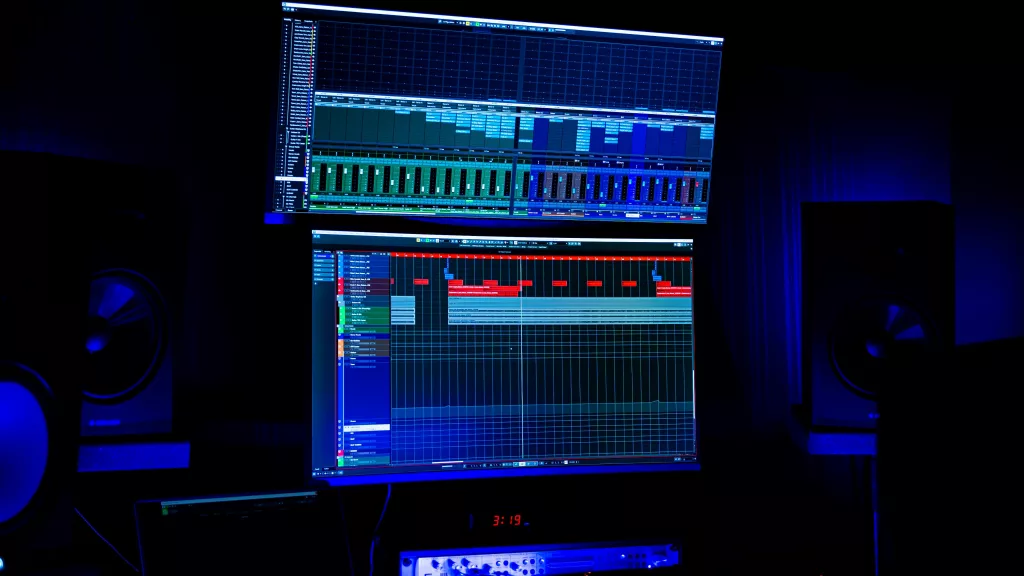The Evolution of Studio Recording Technologies


The history of music recording is a fascinating saga, marked by constant technological evolution.
From early recording experiments on phonograph cylinders to today’s sophisticated digital methods, each step has helped redefine the way music is captured and reproduced.
This article therefore delves into the history of the evolution of studio recording technologies.
The Beginnings: Analog Recording on Magnetic Tapes
The magnetic tape era truly emerged in the 1950s and revolutionized the recording industry.
Before this, recordings were primarily made on analog media such as vinyl records.
Magnetic tapes , therefore using iron oxide coated ribbons, offered improved sound quality and greater flexibility in terms of handling.
Advantages:
- Improved Quality: Magnetic tapes introduced greater sound clarity and better fidelity compared to earlier recordings.
- Editing and Mixing: The ability to edit and mix more easily on magnetic tape therefore revolutionized the way albums were produced.
Disadvantages:
- Sound Alteration: Over time, magnetic tapes could suffer sound alteration due to wear or degradation of the magnetic material.
- Delicate Handling: The tapes were sensitive to handling, thus requiring special care to avoid damage.
The advent of Digital Recording
The 1980s marked a significant transition with the introduction of digital recording.
This method abandoned analog media in favor of converting sound signals into binary digital data.
Digital recorders therefore brought unprecedented precision and eliminated many of the challenges associated with magnetic tapes.
Advantages:
- Consistent Quality: Digital recording has eliminated quality losses linked to tape wear, providing more faithful reproduction.
- Ease of Manipulation: The ability to manipulate recordings in a non-destructive manner has therefore revolutionized the music production process.
Disadvantages:
- “Too Clean” Sound: Some purists believe that the digital nature can sometimes make it sound “too clean” compared to the warmth of analog recordings.
- High Initial Cost: In its early days, digital recording equipment was expensive, limiting access to this technology.


Recording: Harmonious Coexistence
Today, the music industry lives in an ecosystem where analog and digital technologies coexist harmoniously. Many artists and studios combine the best of both worlds.
For example, they use digital recording during production and return to magnetic tapes for mastering.
Advantages:
- Artistic Flexibility: Artists can choose the specific sonic characteristics of each method according to their artistic vision.
- Vintage Effects Emulation: Some studios use digital technologies to emulate the warm, authentic character of analog recordings.
Disadvantages:
- Technical Complexity: Managing analog and digital technologies simultaneously can therefore be complex and requires specific technical skills.
- High Cost: Investing in equipment of both types can therefore represent a substantial financial investment.
The Future: Towards New Innovations?
As we look to the future of music recording, new innovations may emerge, once again redefining the industry standard.
Advances in artificial intelligence, virtual reality, or other areas could shape the way artists record and share their music.
Possibilities:
- AI integration:Artificial intelligence could therefore be used for automated mixing processes or creative recommendations.
- Virtual Recording Experiences: Virtual reality could thus offer immersive virtual studios, allowing artists to collaborate remotely in a shared space.
Potential Challenges:
- AI Ethics:The use of artificial intelligence in the creative process could raise ethical questions regarding artistic authenticity.
- Widespread Adoption: Acceptance of new technologies can take time, and some artists may prefer traditional methods.


Recording: The Emergence of Plugins and IT Production
In recent decades, another major revolution in studio recording has been the advent of plugins and computer production.
Plugins, often in the form of software, allow audio engineers and producers to access a huge range of effects, virtual instruments and mixing capabilities directly from a computer.
This transition to digital has therefore greatly expanded the creative possibilities, providing unparalleled flexibility in sound manipulation.
Advantages:
- Creative Diversity: Plugins offer a range of effects and virtual instruments, allowing for endless creative exploration.
- Accessibility: Simplified digital access makes it easier to share projects between artists and producers, regardless of their physical location.
Disadvantages:
- Abundance Challenge: The multitude of options can sometimes make it difficult to select the tools best suited to a specific project.
- Continuous Learning: Mastering these digital tools therefore requires continuous training to stay up to date with the latest advances.
Recording: The Influence of Streaming Platforms on Production
With the massive advent of streaming platforms, the music industry has had to adapt to new parameters.
Artists and audio engineers now take the specifics of streaming into account during production.
Considerations such as sound dynamics, encoding quality and optimization for different devices therefore become crucial aspects of the recording process.
Impact on Production:
- Sound Optimization: Songs are often optimized for maximum audio quality even with variable internet connections.
- New Mixing Trends: Some artists are adapting their mixes to better align with the preferences of popular streaming platforms.
Challenges:
- Sound Standardization: To meet streaming standards, some fear a tendency to standardize sound to the detriment of artistic diversity.
- Pressure for Quick Introductions: Streaming platforms therefore often favor immediate introductions, influencing the choice of musical arrangements.


Towards an Interactive Listening Experience with 3D Technology
An emerging trend in the music industry is the exploration of 3D technology for a more immersive listening experience.
Companies are developing spatial audio formats, allowing listeners to experience music in a three-dimensional way. This development opens the door to new creative possibilities for artists and producers.
This therefore transforms the way in which music is not only listened to but also felt and above all produced.
Potential Benefits:
- Sound Immersion: 3D technology offers audio immersion, placing the listener at the heart of the musical experience.
- Innovative Creativity: Artists can thus consider new forms of musical expression thanks to this additional dimension.
Potential Challenges:
- Universal Compatibility:Adoption of 3D technology requires compatibility with various devices, which could create experience disparities.
- Listener Learning: Listeners may need to get used to this new dimension. Its success will therefore depend on the acceptance of this new form of listening.
Conclusion
As we explore these new dimensions of evolving studio recording technologies, it becomes clear that the music industry continues to push the boundaries of creativity and innovation.
These changes not only provide new opportunities for artists and producers, but they also redefine the way audiences interact with music.
In conclusion, the evolution of studio recording technology has been marked by dramatic changes from analog to digital, each bringing its own benefits and challenges.
As the music industry continues to adapt to technological innovations, the balance between tradition and modernity remains at the heart of contemporary musical creativity.
